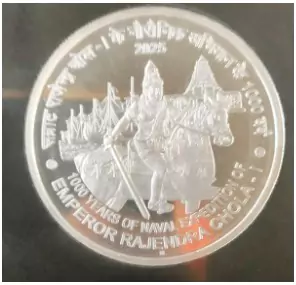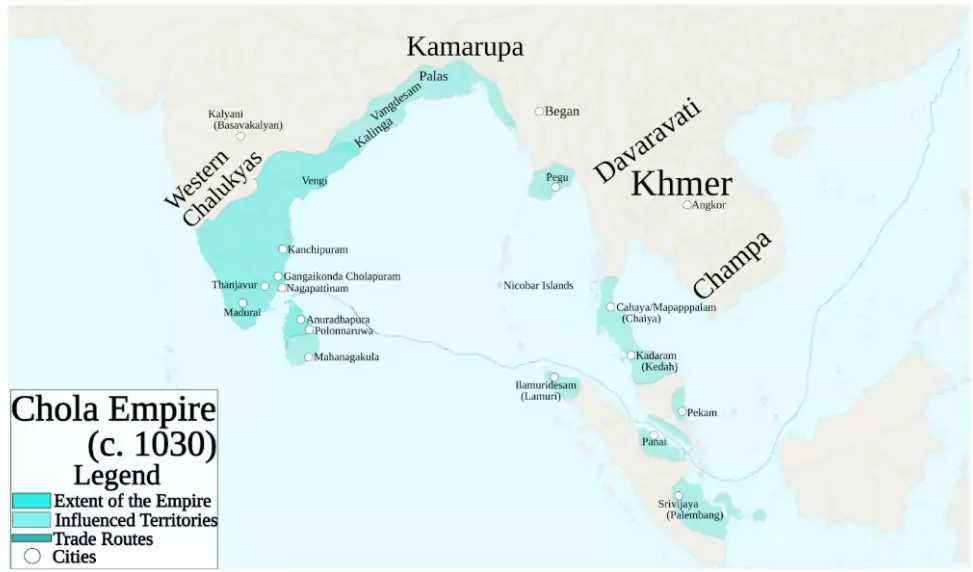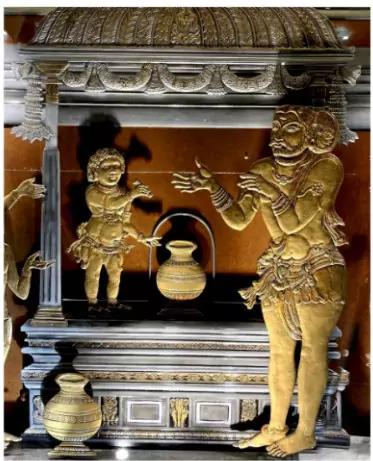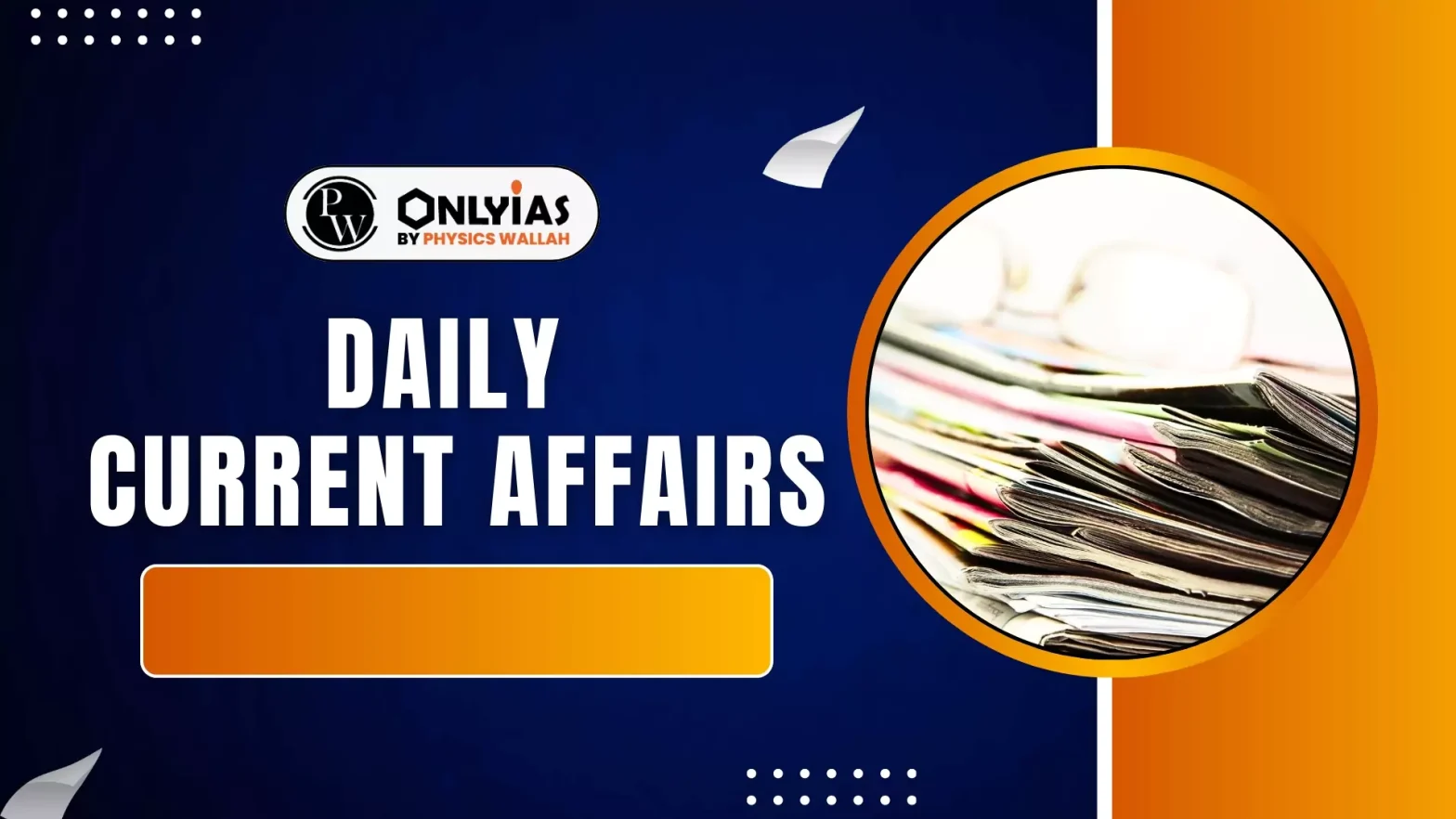Prime Minister Narendra Modi attended the Aadi Thiruvathirai festival at Gangaikonda Cholapuram, Tamil Nadu.
- He hailed the Chola dynasty’s governance, cultural influence, and naval strength as a model for India’s development.
About Aadi Thiruvathirai festival
- Aadi Thiruvathirai is a significant Tamil Shaiva festival, celebrated at the temple to honour the deep-rooted Shaiva Bhakti tradition.
- It reflects the devotional legacy promoted by the Chola dynasty and celebrated through the hymns of the 63 Nayanmars, the saint-poets of Tamil Shaivism.
- This year’s celebration is especially meaningful as it aligns with the birth star (Thiruvathirai/Ardra) of Rajendra Chola, beginning on July 23.
|
Key Announcements

- Statues of Rajaraja Chola and Rajendra Chola I to be erected in Tamil Nadu.
- Commemorative coin issued in memory of Rajendra Chola I.
- Emphasis on integrating Chola legacy into national consciousness.
- Highlighted India’s efforts to preserve and repatriate ancient artefacts—600 retrieved since 2014, 36 from Tamil Nadu.
Who Were the Cholas?
- The Cholas were among the three major dynasties of early Tamilakam, often referred to as the Muvendhar in Sangam literature. They also find mention in Ashoka’s rock edicts.
- The Chola empire saw a revival in the mid-9th century under Vijayalaya, likely a former vassal of the Pallavas.
Key Chola Rulers & Their Contributions
Vijayalaya Chola (848–871 AD)
- Founder of the Imperial Chola Empire; rose to power by exploiting Pandya–Pallava rivalry.
- Captured Thanjavur from the Muttaraiyar dynasty; built a temple for Goddess Nishumbhasudini (Durga).
- Initiated urban renovation of Thanjavur.
Rajaraja I (985–1014 AD)
- Led naval expeditions; conquered parts of Sri Lanka, Maldives, and the west coast of India.
- Appointed viceroys in conquered regions: Chola-Pandya (Pandianadu), Chola-Lankeswara (Sri Lanka), and Chola-Ganga (Karnataka).
- Constructed the Brihadesvara Temple at Thanjavur; temple inscriptions record his achievements.
- Supported cultural diplomacy by aiding the construction of a Buddhist Vihara in Java.
Rajendra I (1014–1044 AD)
- Extended control up to the Tungabhadra River and led northern campaigns up to the Ganges.
- Assumed the title Gangaikonda; built Gangaikonda Cholapuram to commemorate victory over Palas.
- Conducted successful naval expeditions against the Srivijaya kingdom (Sumatra), expanding maritime influence.
- Held titles like Kadaramkondan, Mudikonda Cholan, and Pandita Cholan.
- Promoted trade across the Malaya peninsula; strengthened Chola naval power.
Kulottunga I (1070–1122 AD)
- Unified Eastern Chalukyas of Vengi with the Cholas, ensuring political consolidation.
- Introduced land surveys and revenue reforms (contemporary with England’s Domesday Book).
- Practiced religious tolerance: Though a Shaivite, supported Buddhist shrines at Nagapattinam.
- Faced territorial losses (Vengi, Gangavadi) and invasions by Hoysalas and Pandyas, marking the beginning of decline.

Why the Chola Legacy Matters?
- Strategic and Naval Strength
-
- Rajaraja Chola built a formidable navy and Rajendra Chola I led overseas expeditions to Sri Lanka, the Maldives, and Southeast Asia marking early assertions of India’s maritime power and foreign outreach.
- PM Modi linked this legacy to modern initiatives like Operation Sindoor, highlighting India’s current focus on defence and maritime security.
- Administrative Excellence: The Cholas pioneered local self-governance through the kudavolai system, an early form of electoral democracy.
- Water Management: The Cholas implemented advanced water conservation systems, like Cholagangam lake.
- Cultural Diplomacy and Unity: The dynasty built strong trade and cultural links across Asia.
- PM recalled modern efforts like Kashi Tamil Sangamam and Saurashtra Tamil Sangamam that mirror the Cholas’ push for cultural unity.
- Cultural Unity and Heritage Preservation: Through trade, temple architecture, and diplomacy, the Cholas spread Indian influence across Southeast Asia visible in monuments like Angkor Wat and Borobudur.
- PM Modi compared this to contemporary efforts like Kashi Tamil Sangamam and Saurashtra Tamil Sangamam, which aim to reinforce India’s cultural bonds.
- PM Modi emphasised Shaivite tradition and teachings of Tirumular (“Anbe Shivam”) as guiding principles for peace and ecological balance.
- Referenced Shiv Shakti Point (Chandrayaan-3 landing site), linking ancient tradition with modern achievements.
- Reiterated the Chola legacy as part of “Ek Bharat, Shreshtha Bharat” vision.
Kudavolai System (“Ballot Pot” Elections)
- Earliest documented form of electoral procedure, based on inscriptions in Uttaramerur, Tamil Nadu.
- Names of eligible candidates written on palm leaves and placed in a pot.
 A young boy, chosen for impartiality, drew lots in public view. A young boy, chosen for impartiality, drew lots in public view.- Ensured transparency, fairness, and collective legitimacy.
- Eligibility Criteria:
- Age: 35–70 years.
- Land ownership: Must own tax-paying land.
- Qualifications: Knowledge of Vedic texts or administrative capability.
- Must be free from criminal records or domestic abuse.
- Disqualifications:
- Debt defaulters, alcoholics, and close relatives of sitting members
- Annual audits mandated; proven misconduct led to dismissal and fines.
- Example: Inscription No. 24 (Epigraphia Indica) records a treasury officer’s dismissal for embezzlement.
|
Key Features of Chola-Era Local Governance
- Administration: Chola administrative framework was built on two foundational units
- Sabha – for Brahmin settlements.
- Ur – for non-Brahmin villages.
- Councils had real administrative powers: revenue collection, irrigation, temple management, and justice delivery.
- Accountability Mechanisms:
- Mandatory annual audits of office-bearers.
- Misappropriation or dereliction of duty led to ineligibility for future roles.
- Moral integrity and civic ethics were central to governance.
Strategic and Cultural Significance
- Deep-Rooted Democratic Ethos:
- Formal electoral rules inscribed in stone (e.g., Uttaramerur inscriptions).
- Reflected grassroots democracy far ahead of Europe’s representative governance systems.
- Integration of Morality with Governance:
- Eligibility and disqualification based on moral conduct, not just status.
- Promoted ethical public service, civic responsibility, and trust.
- Decentralised Administration:
- Power shared with merchant guilds (e.g., Manigramam, Ayyavole).
- Boosted trade networks, governance legitimacy, and sustainable civic systems.
Limitations of the System
- Not fully egalitarian: Excluded women, labourers, and the landless.
- Access to power was limited by caste and property ownership.
Additional reading: Rajendra Chola – 1
![]() 28 Jul 2025
28 Jul 2025



